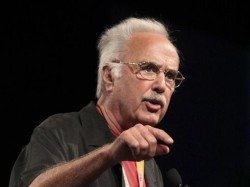
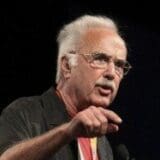
The fight over California’s enterprise zone program continued last Friday when John Burton, chairman of the California Democratic Party, proposed a measure for the November 2014 ballot which would give voters the power to eliminate the zones.
This proposal echoes concerns contained in Frying Pan News reporter Gary Cohn’s exposé of the rampant exploitation of the enterprise zone program. These zones are intended to foster the creation of jobs in economically distressed areas of the state by providing financial incentives to companies to move to those areas. However, a study by the non-partisan Public Policy Institute of California found that “enterprise zones have no statistically significant effect on either business creation or employment growth rates.”
Moreover, Senator Jerry Hill (D-San Mateo) called the enterprise zones “the most abused program I’ve seen,” adding that they amounted to little more than “a big-industry, big-business tax grab.”
Burton is not the only high-profile California Democrat to come out against the zones —
» Read more about: John Burton Measure Would Eliminate Enterprise Zones »
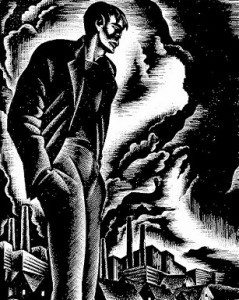

My friend, mentor and colleague, Rev. James Lawson, calls our economic system “plantation capitalism.” Lawson was the nonviolent strategist for Martin Luther King Jr. during the civil rights movement and the key figure in the desegregation of Nashville. His reference, of course, pulls forward the image of enslaved field workers in the Old South.
The image chafes in my mind. Yes, slavery, but today’s workers are not slaves. They are not the landless peasants or sharecroppers that emancipated slaves were forced to be. They are not the low-level, below-the-standard-wage employees that Southern blacks became when they migrated to the steel cities of the North. They are not second-class citizens isolated into segregated neighborhoods and limited to menial jobs.
Except, there is a growing body of evidence showing that this is exactly what a majority of workers of all colors is becoming. Between 1965 and 2011, while the top 10 percent gained an inflation-adjusted annual income increase of $116,000,
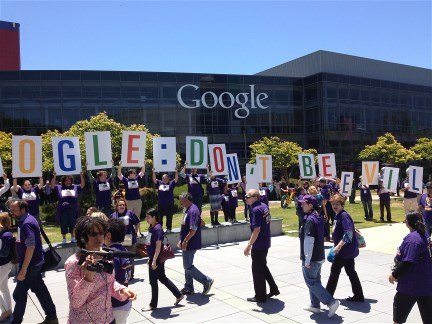

(The following post about the Netroots Nation conference, recently concluded in San Jose, California, first appeared on JesseLuna.com and is reprinted with permission. Jesse Luna is a communications specialist with SEIU Local 721.)
The labor message was strong at the Netroots Nation 2013 conference. There was a consistent message across sessions and activities, a strong focus on the rise of what is being called “Alt Labor” and there were some good worker actions. Labor must be a part of the progressive movement.
Sessions and Activities
It was common to have pro-union voices at the different sessions and even during the activities. During a taco truck lunch event, several elected officials took to the microphone and spoke about the need to raise the minimum wage. Two young people also spoke about their experiences working at fast food places, the low wages and poor working conditions there.
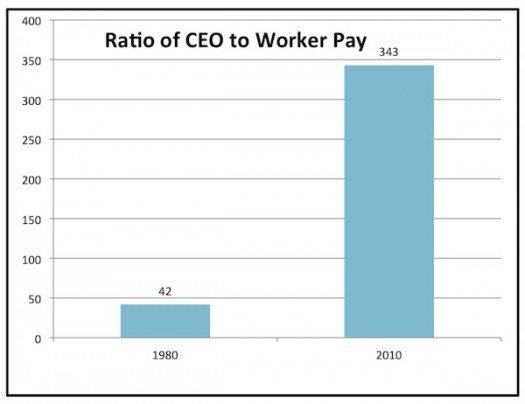
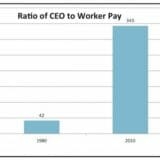
Image source: Center for Popular Economics
When Peter Drucker was writing about executive compensation in the 1970s, his purpose was to puncture some of the myths about it. Executives, Drucker pointed out at the time, weren’t getting paid as much as people seemed to think. At most companies, the ratio of CEO pay to average employee pay was less than 25-to-1, while most Americans erroneously believed it to be 50-to-1 or 100-to-1.
But that would all change in the following decades. Today, the CEOs of the largest U.S. companies make 354 times more than the average rank-and-file worker. At some companies— including Abercrombie & Fitch, CBS and Nike—the ratio is in excess of 1,000 to 1. (See this chart from Bloomberg for details.)
As far as Drucker was concerned, this sort of pay structure was absurd. “It is surely not professional altogether for people who are employees and not “owners” to pay themselves salaries and bonuses greatly in excess of what their own colleagues,


Representative Paul Ryan is back to his old tricks, demonizing people who rely on government to improve their lives. This week, his target was food stamp recipients.
He’s already come out in favor of $20 billion in cuts that will throw an estimated two million children, elderly, and disabled Americans off food stamps. But now Ryan — the millionaire Wisconsin Congressman who was Mitt Romney’s VP running mate last year — is pushing an amendment to eliminate food stamps for people who have $2,000 in savings, or a car worth more than $5,000.
The Congressional Budget Office found that this would throw 1.8 million people off of the program. The Hill reported, “Most of these would be low-income seniors and working families with children. These families typically live paycheck to paycheck. Denying them the ability to save for emergencies, such as fixing a car,
The ripples continue to spread from Frying Pan News reporter Gary Cohn’s piece on California’s enterprise zones, which were created in 1984 to help small businesses and create jobs by giving tax breaks to companies in the state’s economically depressed regions. Last Friday the Fresno Bee called for reform of the zones and today a Los Angeles Times editorial declared that nothing less than pulling the plug on the program would do.
The zones, said the Times, “were a well-intentioned experiment that was tried, failed and has been kept around too long. This is one experiment that should be ended, not merely mended.”
Cohn’s May 28 article appeared at the same time Governor Jerry Brown was maneuvering to reform the program out of existence. The Frying Pan News story emphasized that 61 percent of the enterprise program’s beneficiaries are companies with more than $1 billion in assets,
» Read more about: L.A. Times: Pull the Plug on State’s Enterprise Zones »


Saturday, June 22, Grand Performances will present Inequality for All, a film directed by Jacob Kornbluth in which former U.S. Labor Secretary Robert Reich examines America’s widening economic gap. The documentary, part of L.A. Film Fest, screens free at 8:15 p.m., outdoors, at California Plaza. Frying Pan News reporter Luke Dowling sat down with Michael Alexander, Grand Performances’ Executive and Artistic Director, to ask about the event and Alexander’s vision for Los Angeles’ arts landscape under the city’s new mayor.
Frying Pan News: Why did you decide to include a documentary about economic inequality this season?
Michael Alexander: Documentary filmmaking is an art and some of the documentary filmmakers that we’ve worked with have also touched on the very issues that face people in their everyday lives. What are people going to decide to do for themselves?
» Read more about: Bridging Great Divides: A Talk With Michael Alexander »


Walmart’s expansion strategy for Los Angeles and other urban areas has been to avoid public oversight by choosing real estate that doesn’t require public review – and, where possible, to secure public subsidies, often with little public scrutiny.
This is exactly what happened in both Covina and Cathedral City. In 1993, Walmart negotiated an intricate deal with the City of Covina’s redevelopment agency that resulted in the company making a tidy profit of $4.1 million. Walmart made a $10.8 million loan to the CRA to purchase several plots of land for the corporation, which was then sold back to Walmart at the discounted price of $6.7 million. In this way, Walmart effectively received a $4.1 million subsidy from taxpayers to develop the land. Similarly, in 1995, Walmart was reimbursed by Cathedral City for $850,000 for “infrastructure improvements,” but on the day that taxpayers recovered this subsidy,
» Read more about: Unlevel Playing Field: How Taxpayers Foot Walmart’s Bills »


One of the biggest issues that the Affordable Care Act (ACA) is meant to tackle is the lack of health coverage among low-wage workers. While there is good news for many low-wage workers in the new law, many others will still find themselves locked out of access to affordable coverage. Solving their concerns will be one more part of the huge challenge of confronting the power of mammoth low-wage employers in the new economy.
There has been a lot of coverage about the potential for fast food chains and other employers to cut the hours of some of their employees to under 30 a week in order to avoid having to offer them health coverage. To the extent that employers do cut back hours, it will accelerate a long trend toward part-time low wage work; part-timers increased from 17 percent to 22 percent of the workforce just from 2007 to 2011.


There’s power in the picket line. And employers know it.
That’s why, in 2008, Ralphs Grocery Company sued to have union picketers removed from the front of one of its non-union stores. But California has explicit laws to protect labor-related speech, and the court denied the request by Ralphs.
But that hasn’t stopped the grocery chain from continuing its courtroom battle to silence workers – even though they’ve lost just about every case. Last December, California’s Supreme Court upheld the ruling in favor of the picketers. Speaking for the California Supreme Court’s 6-1 ruling in the Union’s favor, Justice Joyce Kennard wrote that the 1975 state law and follow-up legislation passed in 1999 are
“. . . justified by the state’s interest in promoting collective bargaining to resolve labor disputes, and the understanding that the area outside the entrance of the targeted business often is the most effective point of persuasion.”
And last week,
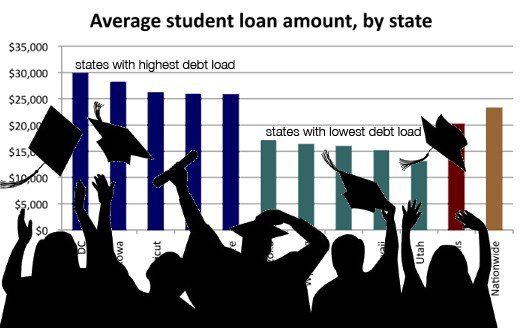
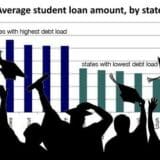
“Work hard. Get good grades. Go to a good school and you will be successful.” Our generation has been told time and again that through hard work and dedication, we will be able to live happy lives, have secure jobs, and start families built on comfortable finances. But on the day of action around student debt, it [was] clear we need more than these easy answers to help Millennials cope with the growing burden of education costs.
I come from a middle class family. Both of my parents served in the Marine Corps and got good jobs. My father works in law enforcement, and my mother is a teacher. They taught me that if I put in hard work, I would reap the results. So, I graduated at the top of my class in high school and went to a top (public) university. I worked all four years of college and graduated on time.
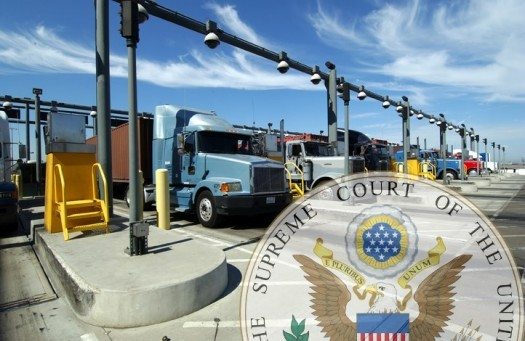

Last Thursday the U.S. Supreme Court ruled in a case that had the potential to impact millions of people in Southern California – people who have been breathing cleaner air thanks to the Port of L.A.’s Clean Truck Program. The Clean Truck Program is an innovative policy that has been successful in reducing port-related truck emissions by as much as 90 percent. But it has enemies, most notably the trucking companies who profited from the dirty, unregulated system as they worked on behalf of Walmart, Target, and every other big importer.
The national trucking lobby, on behalf of these firms, sought to kill the program by challenging it in court. As we passed environmental and public health milestone after milestone, the trucking industry filed legal motion after legal motion, and the case bounced between all levels of courts. But Thursday was the big one—the highest court in the land finally weighed in on the legality of the program overall.
» Read more about: Supreme Court Blocks Industry Bid to Kill Clean Truck Program »
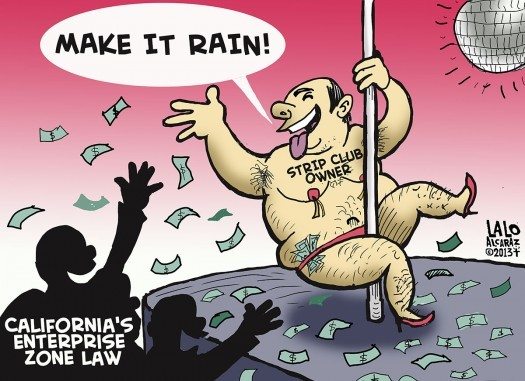
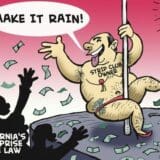
In How Enterprise Zones Are Killing the California Dream, Frying Pan investigative reporter Gary Cohn looked at the impact of the controversial program, including workers who lost their jobs while their former employers received tax breaks for hiring lower-paid replacements. He also reported on two strip clubs revealed to have benefited from the secretive program. Other media have picked up the story as well, building momentum for an overhaul. A more detailed overview of the Governor’s plan can be found here. The following post first appeared in the blog Labor’s Edge.
To some politicians, economic development means giving hundreds of millions of taxpayer dollars to strip clubs, fast food joints and retail giants like Walmart. Gov. Brown, thankfully, has a better idea. Today, the Governor announced a broad coalition of labor, business and others in support of his good jobs plan that will flip the broken enterprise zone program into real incentives for creating quality,
» Read more about: Governor Brown Outlines Plan for Good Jobs »


How a union of Yale employees aligned itself with community activists and won control of a beleaguered city.
This article and illustration originally appeared in The American Prospect.
Major Ruth became a civic leader because he made a promise to his neighbor, Brian Wingate. Both had moved to the Beaver Hills section of New Haven, Connecticut, in 2003. A neighborhood of aging single–family homes that had seen better days, Beaver Hills had been targeted by the city for a housing–rehabilitation program, and, with the zeal of new arrivals, Ruth, a manager at the local utility company, and Wingate, a custodian and union steward at nearby Yale University, sought to involve themselves in neighborhood–improvement ventures. That proved harder than they had anticipated. Although New Haven aldermanic districts are tiny, encompassing no more than 4,300 residents, Ruth and Wingate couldn’t find anyone who could identify,


Last Friday, my wife, Susan, was out where Santa Monica meets Brentwood to tell the President not to approve the Keystone XL pipeline. No one caught a glimpse of him, of course. What she did see were scores of expensive cars moving down San Vicente – black, big SUVs, as usual, and top-of-the-line Mercedes and BMWs but also Jaguars, Ferraris, a Rolls, even a Lamborghini, plus others she couldn’t name. These cars begin at $75,000 and go to the mid-six figures.
Also trying to wind though the traffic maze were the workers, gardeners in small, beat-up Toyota pickups, house maids in compacts from 20 years ago, bunches of Latinas waiting at the bus stop for public transportation and delayed by the President’s presence at a fundraiser in a nearby home. The juxtaposition of the vehicles of the very wealthy and those of their servants was what she found remarkable about the experience.
» Read more about: Santa Monica’s Lethal Shootings and the Culture of Economic Desperation »
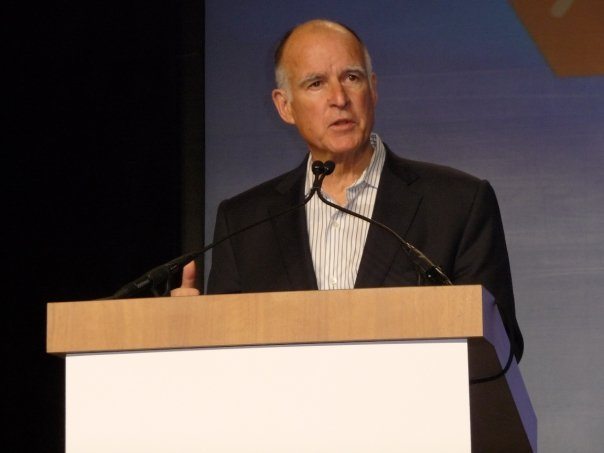
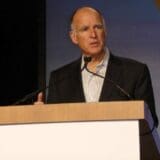
In How Enterprise Zones Are Killing the California Dream, Frying Pan investigative reporter Gary Cohn looked at the impact of the controversial program, including workers who lost their jobs while their former employers received tax breaks for hiring lower-paid replacements. He also reported on two strip clubs revealed to have benefited from the secretive program. The governor and legislators have now put forward proposals to reform the program or replace it with other economic development programs. This post originally appeared in Labor’s Edge.
You’ve probably seen the stories by now: Enterprise zone tax breaks, which are supposed to provide incentives for good jobs, are instead going to strip clubs and low-wage mega corporations like Walmart.
The current enterprise zone program is shrouded in secrecy, with virtually no accountability or transparency. Study after study shows the program is a massive failure,
» Read more about: End the Enterprise Zone Abuse: Gov. Brown’s Good Jobs Proposal »


America’s economy will suddenly grow by $400 billion — roughly three percent –on July 31, when the Bureau of Economic Analysis begins to include in its GDP calculations the value of investments in such intellectual property products as songs, books and movies. The new numbers will reveal that Stephen Sondheim, Stephen King, Steven Spielberg and Ray “Even Stevens” Stevens have been far more important to the nation’s financial well-being than government stats have previously indicated.
This news feels as uplifting as a double dose of premium-grade placebo. But there’s more than feel-good bookkeeping at stake here. Plays, stories, films and music generate wealth – wealth government stats are supposed to measure.
The nation has always struggled with who owns that wealth. In the Wild West frontier of the internet, music, films and news were easily pirated. Now, there’s a newer, quite possibly wilder West,
» Read more about: Digital Fabrication: More Than the Stuff of Dreams »
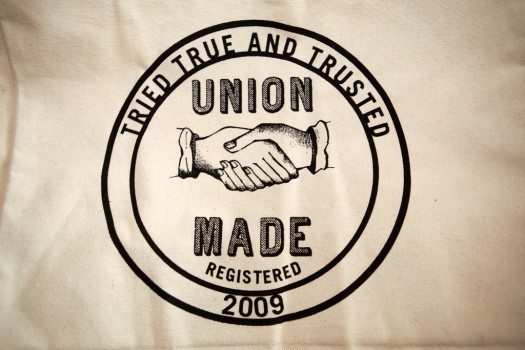
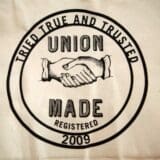
There are many similarities between the civil rights movement of the 1950s and ’60s and the union movement that preceded it in the early decades of the 20th century. Both met with hostility, opposition, and violence. Yet today we look back on the former with gratitude and admiration, while the latter is either forgotten or distorted in our collective memory.
Hard-fought union gains have become part of the fabric of our society: the eight-hour day, elimination of child labor, and safer conditions are but a few of the benefits that unions have secured for all of us. Yet unions have been broadly demonized, and the gains they have won are slipping away.
I’ll be the first to admit that unions have their issues. Nevertheless, I am grateful that my husband and I have been loyal union members all of our adult lives (I am a teacher; he is a Teamster).
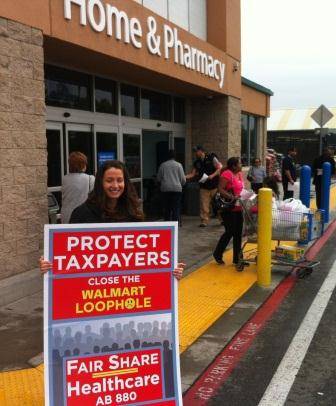
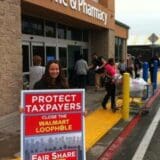
We all know that working for Walmart is no picnic. They pay low wages, they slash hours, they offer little or no job security, they exploit and intimidate workers and they use sweatshop labor. That’s why Walmart workers are on strike this week, to protest the corporation’s greedy behavior and shady business practices. Learn more about the strike here.
Many of these striking workers earn so little that they’re eligible for public assistance, like food stamps and Medicaid. And that’s no accident; it’s exactly the way Walmart likes it. We as taxpayers foot the bill for their workers, and the corporate head honchos get even richer.
According to a new report released today by the California Works Foundation:
[Walmart] workers use 40% more public health care assistance than the retail average. The company’s use of public assistance costs California $86 million per year,
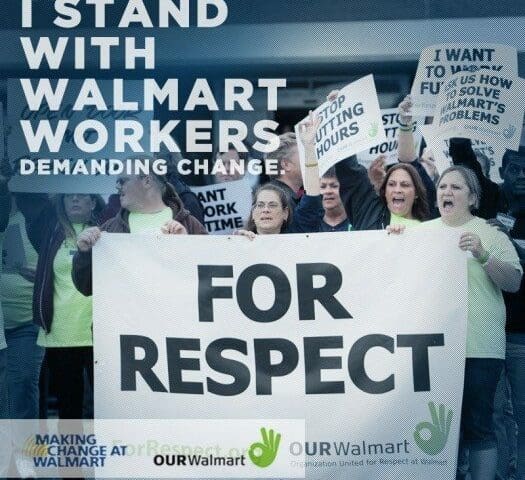
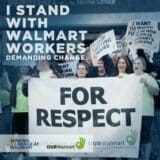
This week, Frying Pan News has been following stories as Walmart workers joined caravans coming from across the country, converging at the company’s annual shareholders meeting in Bentonville, Arkansas. This post originally appeared on MakingChangeAtWalmart.org. Video of the action is here.
What a week! After an action-packed journey, the six Ride for Respect caravans all arrived safely in Bentonville, Arkansas over the weekend. But the buses of #Walmartstrikers were not about to sit around until Friday, when Walmart’s annual shareholders meeting will take place–that’s for sure!
[Mon] morning, a group of 200 OUR Walmart members and supporters marched through the misty dawn to Walmart’s Home Office, and arrived just as the employees at the headquarters were filing into work. Quietly, the throngs of green shirts spread out in front of Home Office–many in the crowd had tape-covered mouths with “ULP strike” written across,
» Read more about: Action at Walmart’s Home Office as Caravans Arrive in Bentonville! »